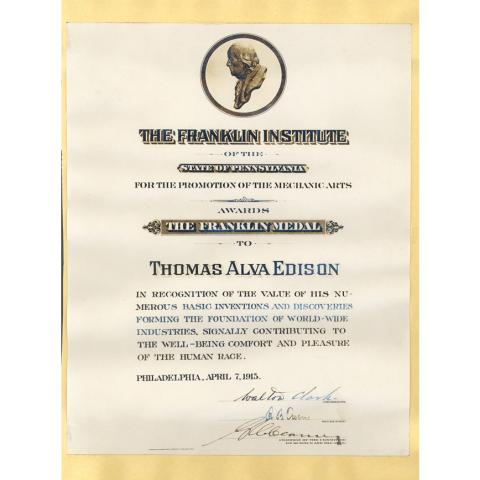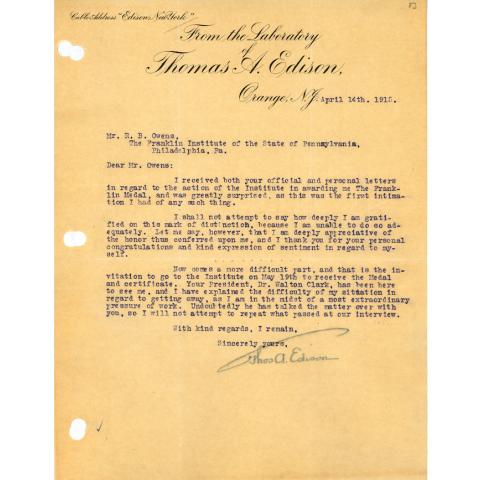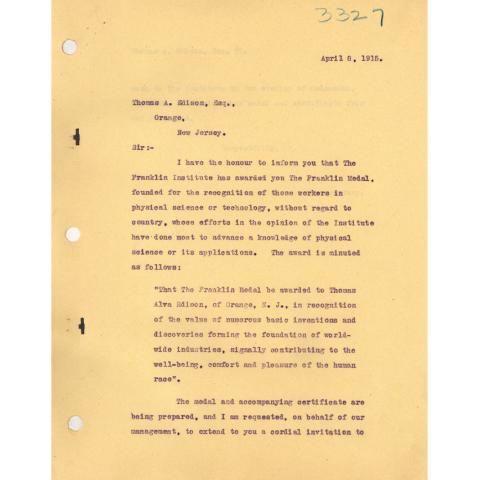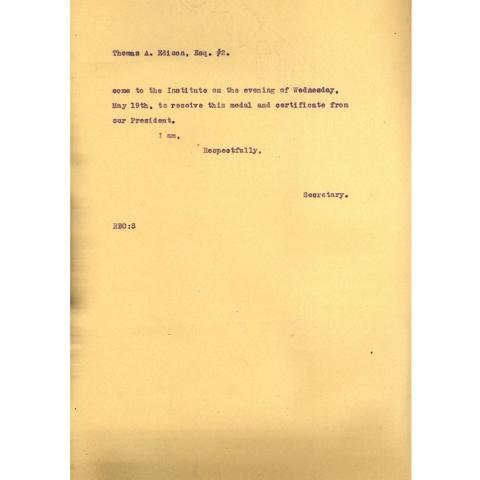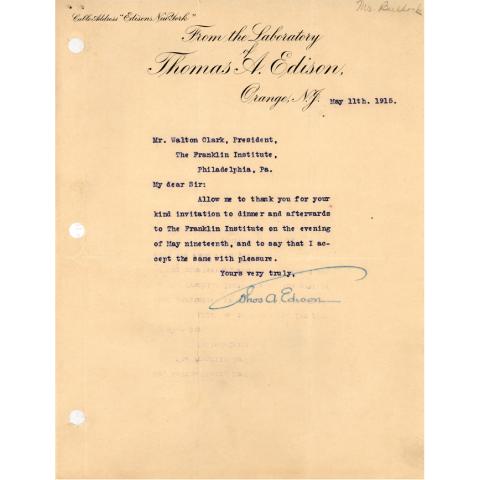Introduction
What was Thomas Alva Edison's most important contribution to the history of science? Improvements to the lightbulb? The phonograph? In fact, Edison's most significant contribution was his "method of invention”. Nicknamed "The Wizard of Menlo Park”, Edison was not particularly wizardly. Rather, he was a savvy businessman who understood the value of iterative invention. His influence on the science and technology of the twentieth century is immeasurable.
But just who was Thomas Alva Edison? How did his inventive genius contribute to the "well-being, comfort, and pleasure of the human race”? And how did Edison's determination and quest for knowledge factor into his success?
A Studious Youth
Thomas Alva Edison was born in Milan, Ohio, on February 11, 1847, the seventh and last child of Samuel and Nancy Edison. Samuel was a militant freethinker who had been banished from Canada; Nancy was a former teacher. Thomas received most of his education from his mother and the books in his father's library. His later commercial acumen was most likely inspired by his father's many diverse business ventures.
At the age of 13, when his problems with gradual hearing loss began, Edison started working as a traveling candy salesman on the new railroad system in the Midwest. Capitalizing on all learning opportunities around him, he ran his chemical experiments during train trips and began to study the burgeoning field of telegraphy. Within five years, he had become an expert telegrapher and part of a wandering group moving between Midwestern cities. All the while, Edison studied the technical aspects of telegraphy in his own workshop.
Full-Time Inventor
Encouraged to move to Boston in 1868, Edison began working there for Western Union, arriving in the midst of the telegraphic expansion. There, he saw the array of new developments and inventions, met financial supporters, and set up his new workshop. In the financial industry at that time, rapid, accurate, and documented communications were the foremost need. Taking advantage of this, in 1869, Edison filed his first patent application covering a printing telegraph and left Western Union to work full-time as an inventor.
His next stop was New York. During the 1870s, Edison lived to invent and his pace was frantic. He formed numerous partnerships, continually improving and expanding automatic telegraph equipment, maintaining investment support, and enduring litigation. In 1871, Edison married a 16-year-old employee, Mary Stilwell, and during the next eight years three children—Marion, Thomas Alva, and William—were born.
Menlo Park
Edison built his first experimental laboratory in Menlo Park, New Jersey, in 1876. This laboratory was designed to be staffed by scientists engaged in basic research rather than immediate commercial products. Such an approach to the creation and development of inventions was a novel concept in the United States; it was an original model for scientific endeavor that continues to this day, supporting the comment of Alfred North Whitehead that "the greatest invention of the nineteenth century was the invention of the method of invention”.
Switch of Genius
Towards the end of the 1870s, Edison's inventive genius switched from telegraphs to telephones. Western Union hired him to devise an improvement on the telephone recently invented by Alexander Graham Bell; the strength, and thus, the range of the sound signal needed to be increased. Edison chose to solve the problem by improving the transmitter; he adapted a characteristic of carbon: its high electrical sensitivity—the same characteristic that had doomed its use in an earlier invention. Eventually Bell Telephone Company adopted this transmitter design and it served in handsets for the next one hundred years.
In the beginning, the telephone was viewed as a replacement for the telegraph, and again, as with his printing telegraph, Edison set out to build a device that would create a permanent copy of a spoken telephone message. Edison's solution was a machine that recorded the vibrations of the spoken message received and then replayed the vibration patterns slow enough that the telegraph operator could transcribe it. Of course this new "talking machine" was the phonograph, but, apart from a private demonstration, there was no immediate commercial capitalization of this amazing invention. 10 years later, commercial production of the improved phonograph began, the recording industry was launched, and Edison's fame was sealed.
Lighting System
Edison closed the 1870s with a further world-changing achievement; the mission to replace gas lighting systems with a safer, easier electric version suited Edison's unique ability to combine existing fragmentary knowledge into a practical, operating whole. The construction of the electric power and lighting system, begun in 1878, was a huge undertaking in every way: concept, imagination, manpower, financial funding, research, manufacture, and marketing. These, together with painstaking research, required the production of every element in the process from the electricity generators, through the entire distribution system, to the final light bulb and switch. The resulting system went live at the Pearl Street plant in New York City on September 4, 1882.
In 1880, while experimenting with light bulb filaments, Edison's team discovered and patented the "etheric (or Edison) effect" in which electricity was detected passing through the vacuum from the heated filament to a metal plate. While not recognizing the importance of this phenomenon at the time, Edison was later able to direct the patented rights to Guglielmo Marconi for use in his wireless telegraphy discoveries.
Setback and Ambition
In 1884, Edison's wife Mary, who had been ailing for some time, died in the twelfth year of their marriage. Her death caused a cutback in Thomas Edison's work, but with his 1886 marriage to Mina Miller, his ambition was renewed. He closed the Menlo Park laboratory, replacing it with a larger, improved version in West Orange, New Jersey. Research and development on electric lighting continued for the next few years, but was marked by the conflict between the adoption of Edison's DC (direct current) electrical current and Tesla's AC (alternating current) systems for power distribution system. The AC system reduced power loss and improved transmission distance since the power voltage could be stepped up at the source to improve transmission and then stepped back down to usable levels at the delivery destination. Eventually, despite Edison's pro-DC efforts, the AC system was adopted universally.
Soon after, in 1892, Edison merged his various electric companies into the General Electric Company and moved on to a variety of other interests, primarily the possibilities of the sound recording machine he had made many years earlier. Building on the work of Bell and Tainter, Edison built improved wax cylinders and electrically-driven phonographs, more expensive than the hand-cranked versions but providing better sound quality. For the phonograph's commercial success, Edison was now competing with the Victor Talking Machine Company's disc phonograph. In this new era of scientific discoveries, moving into the field of entertainment, Victor won; Edison's venture finally closed in 1929.
Interesting Pursuits
Edison was in at the beginning of the motion picture industry when he provided the germ of the idea for the camera and kinetoscope viewer and supported his researcher, W.K.L. Dickson, in his experiments. Although they patented 75 simple motion pictures in 1894, it was left to others to advance this new industry.
Other interests that Edison pursued at this time (some more successful than others) included: a venture to separate iron and gold ore, devising x-ray equipment, manufacturing cement, and building electric storage batteries. The latter two were successful with his cement processing patents being licensed by other companies and the batteries finding use in electric vehicles, leading to the formation of an international manufacturing company.
In 1907, now a 60-year-old father of six with increasing hearing problems, Edison announced his decision to leave behind commercial development and devote his time to research.
His retirement plans were partially successful. He did spend more time traveling the country, vacationing at his winter retreat in the village of Fort Myers, Florida, and accepting the many honors given him. However, he also found time to work on the manufacture of storage batteries, his most profitable venture of all. In addition, he accepted appointment to head the Naval Consulting Board which was formed in 1915, two years before the United States entered World War I, remaining in that position until 1921.
A Fitting Tribute
Edison's companions on his travels were an illustrious group: President Harding, Henry Ford, George Firestone, and naturalists Luther Burbank and John Burroughs. Calling their group the Nature Club and driving in automobiles, they undertook camping trips throughout the eastern United States, enjoying the country over an eight-year period until Harding's death in 1923.
Research continued to be Edison's lifelong enthusiasm; his last patent application was filed in January, 1931—the year of his death.
Following Edison's death on October 18, 1931, President Hoover issued a statement requesting that all Americans turn off their lights for one minute at ten o'clock Eastern Standard Time as a tribute to the great man's memory. Similar interruption of generating machinery was suggested, but deemed too dangerous since so many essential services relied on electric power—a fitting demonstration of the debt owed to Thomas Edison's unique efforts.
Telephone Transmitter
The telephone, invented by Alexander Graham Bell in 1876, converted the sound waves from the human voice into electric impulses, conducted the impulses through a wire, and converted them back into the human sound at the other end of the wire. The originating transmitter contained a parchment membrane that vibrated in response to sound. A metal button attached to the membrane sent the varied movements to an electromagnet and electric current corresponding to the vibrations induced. This induced current traveled to the receiving device, and where the process was reversed, the electricity caused movement of a magnet which then caused a membrane to vibrate and emit the corresponding sounds.
Thomas Edison worked to improve a drawback in Bell's invention: the weakness of the electric signal limited the quality and distance of the message. His approach was to improve the sensitivity of sound detection at the transmitter by replacing the parchment membrane with a disc of compressed carbon set between metal plates. The electrical resistance of carbon is extremely sensitive to the minute pressure changes caused by sound waves. Edison's solution—improved later by substitution of granulated carbon and then roasting of the granules—became a basic component of telephones for almost a hundred years.
Electric Lamp
In 1847, when Thomas Edison was born in Ohio, local transportation was horse-drawn, inter-city railroads were new, and oil lamps or sometimes gaslights were used for illumination. At the end of his life in 1931, public transportation included the automobile and the airplane, and there was widespread availability of electric power. Edison's innovative approach to invention propelled the development of the electric light plus the generation and distribution system to make it work.
Edison improved upon previous designs to produce the first reliable, commercial electric light bulb. The basic design was a sealed, evacuated glass bulb containing a filament connected by wires to an outside source of electric current. By devoted effort, Edison and his team solved problems with the filament material and improved the vacuum quality, preventing the presence of oxygen that would cause the filament to burn up at the high temperature created by the electric current. The best filament material needed to have high durability for long bulb life and high electrical resistance to provide the brightest light with the least required electrical consumption.
Over a two-year period, Edison tested thousands of filament materials from the prosaic (metals) to the exotic (tropical vegetation) in a worldwide search. A coiled carbon filament is shown in his landmark invention, named the Edison Incandescent Lamp and given U. S. Patent No. 233,898 on January 27, 1880. The final result was an inexpensive, easily manufactured 16-watt lamp bulb that ran a on DC current for up to 1500 hours.
Electricity Generator
Edison built on the 1831 work of Michael Faraday to create the electricity generator used to power his lighting system.
Faraday discovered electromagnetic induction, production of an electric current, by spinning a copper disc between the poles of a magnet and detecting the current that resulted in wires connected to the disc.
Edison's innovative application of Faraday's principles was a steam-driven generator that included very large bipolar magnets to improve efficiency and had slight electrical resistance compared to the resistance of the wire distribution network linked to it. It supplied direct current power.
Along with the lamps and the generator, Edison designed and built all of the ancillary equipment: underground supply cables, junction boxes, lampholders, switches, sockets, meters, etc. In effect, this complex combination established the fundamentals of large-scale electricity distribution. The Pearl Street station in Manhattan went live at 3PM on September 4, 1882, supplying 4,400 lamps in 193 buildings and continued to operate and expand for eight years.
Eventually, Edison's system was replaced due to the work of Nikola Tesla, who had first worked for Edison. He devised alternating current (AC) generators. AC current can be easily and efficiently sent over long distances with little power loss because it is "transformable." The current is generated and its voltage increased for transmission over the wire power grid and then decreased to lower, safer voltage at its destination. The AC electrical system continues to be the world standard.
Phonograph
Edison had always worked overlapping projects and such was the case with the phonograph. His first ideas of the phonograph came at the same time that he was working on the telephone transmitter. The phonograph was related to his previous inventions which were created in attempt to obtain a permanent copy of telegraph messages. He pondered ways of creating a permanent copy of messages sent by telephone. In fact, his February 19, 1878 patent refers to the "Phonograph or Speaking Machine."
The original tinfoil phonograph had three components:
- The speaker tube containing a diaphragm attached to a scribing stylus
- A four-inch diameter metal drum attached to a hand crank and wrapped around with a roll of tinfoil
- The listening tube, very similar to the speaking tube, containing a detecting stylus attached to a diaphragm.
In operation, spoken sound entered the speaking tube, causing the diaphragm to vibrate. The vibrations passed through the stylus and were inscribed on the tinfoil in a vertical groove (hill and dale) pattern while the drum was being rotated by hand at 60 revolutions per minute. When the stylus of the listening tube rode over the recorded indentations, the resulting vibrations passed through the detecting stylus and vibrated the listening diaphragm to reproduce the speech in the listening tube. The cylinder had a three-minute recording capacity. It was on this machine that Edison created the first recording of human voice as he recited "Mary Had A Little Lamb”. Public demonstrations cemented Edison's reputation as an outstanding inventor.
For commercial applications, the tinfoil material proved too flimsy and Edison switched his attention to his light bulb experiments. Meanwhile, other inventors such as Alexander Graham Bell and Charles Sumner Tainter worked on improving Edison's invention. The result was a change from tinfoil to wax cylinders with a floating, less destructive stylus. Edison then turned his attention back to the phonograph; the Menlo Park laboratory went to work and produced an improved wax cylinder machine in 1889.
A novel and expensive feature of this machine was the electric motor included to drive the drum. The expense limited its market to office-dictating machine uses and Edison moved on again to other research. He later had some success with reproducing phonograph recordings and with a dictating phonograph, the Ediphone.
In the 10-year period after Edison’s innovations with phonograph technology, the phonograph industry had turned to longer playing, more durable discs rather than cylinders as a recording medium, and music was now the recording content. While Edison adapted to this with new materials to improve disc recording, copying fidelity, and a spring drive motor, his product was incompatible with other systems and his endeavors were overtaken by companies such as the Victor Talking Machine Company and Columbia.
Acknowledgement
In 1915, Thomas Alva Edison was awarded the Franklin Medal in Engineering for "Discoveries contributing to foundation of industries and the well-being of the human race."
The full text of the award citation reads: "In recognition of the value of his numerous basic inventions and discoveries forming the foundation of world-wide industries, signally contributing to the well-being comfort and pleasure of the human race."
The Committee on Science and the Arts report on Case File No. 2640 and 2641, dated March 3, 1915, is at right. Heike Kamerlingh Onnes, of Leiden, Holland, also received a Franklin Medal that year, "in recognition of his long-continued and indefatigable labors in low-temperature research which have enriched physical science not only with a great number of new methods and ingenious devices, but also with achievements and discoveries of the first magnitude."
Credits
The Thomas Alva Edison presentation is made possible by support from The Barra Foundation and Unisys.
This website is the effort of an in-house special project team at The Franklin Institute, working under the direction of Carol Parssinen, Senior Vice-President for the Center for Innovation in Science Learning, and Bo Hammer, Vice-President for The Franklin Center.
Special project team members from the Educational Technology department are:
Karen Elinich, Barbara Holberg, Margaret Ennis, and Jay Treat.
Special project team members from the Curatorial department are:
John Alviti and Andre Pollack.
The project's Advisory Board Members are:
Ruth Schwartz-Cowan, Leonard Rosenfeld, Nathan Ensmenger, and Susan Yoon.
Read the Committee on Science and the Arts Report on their awarding of the Franklin Medal to Thomas Edison.


